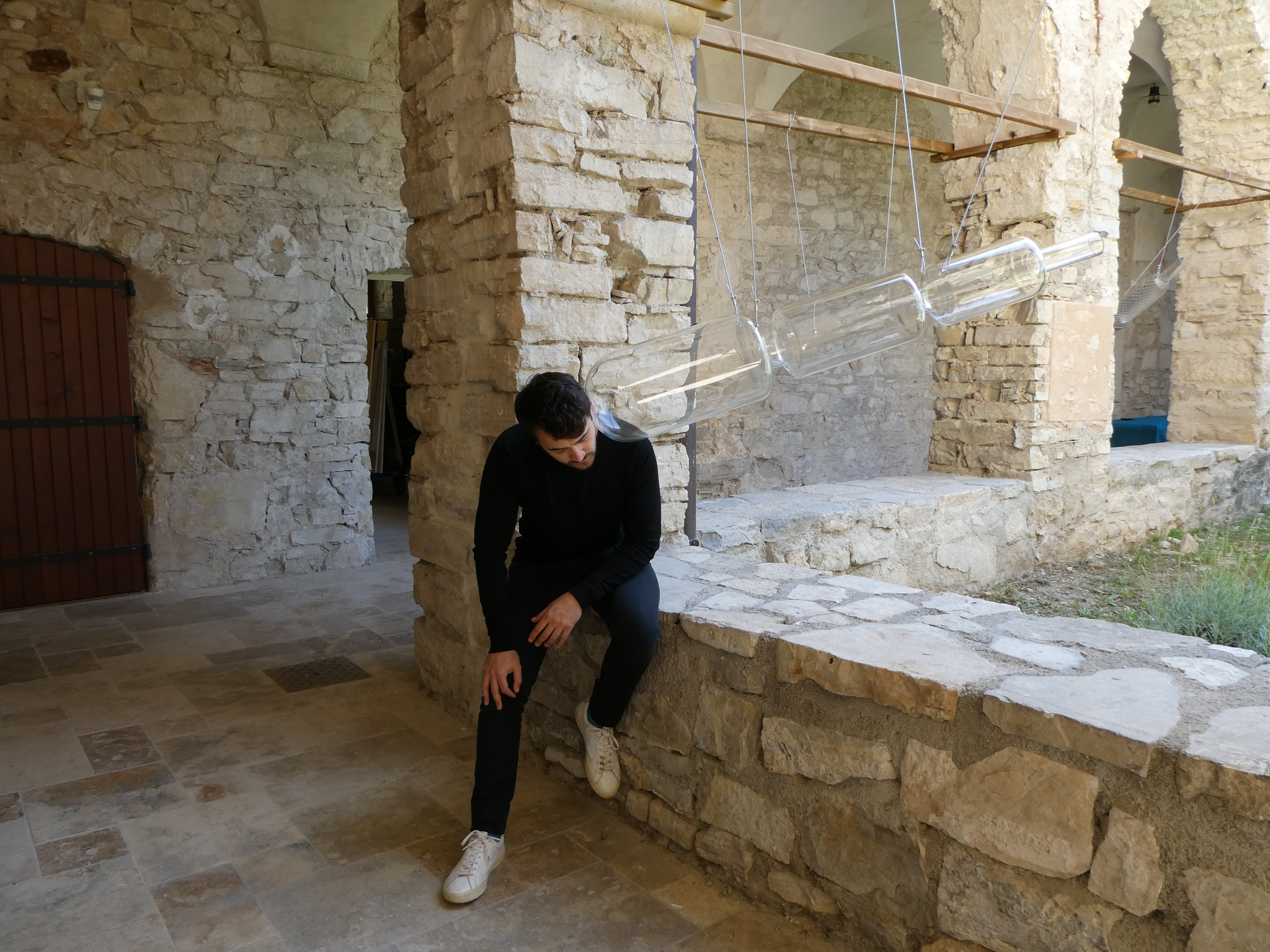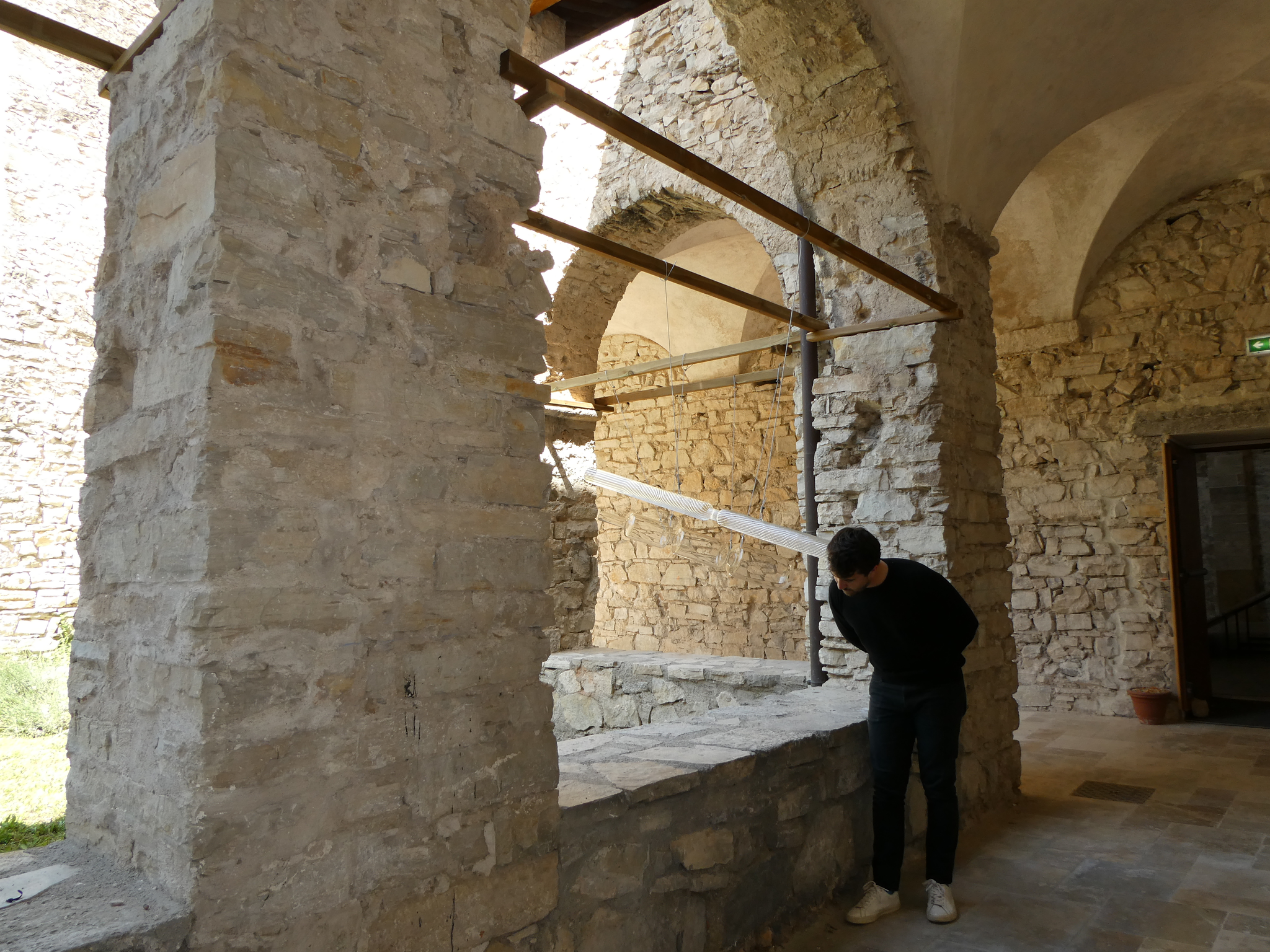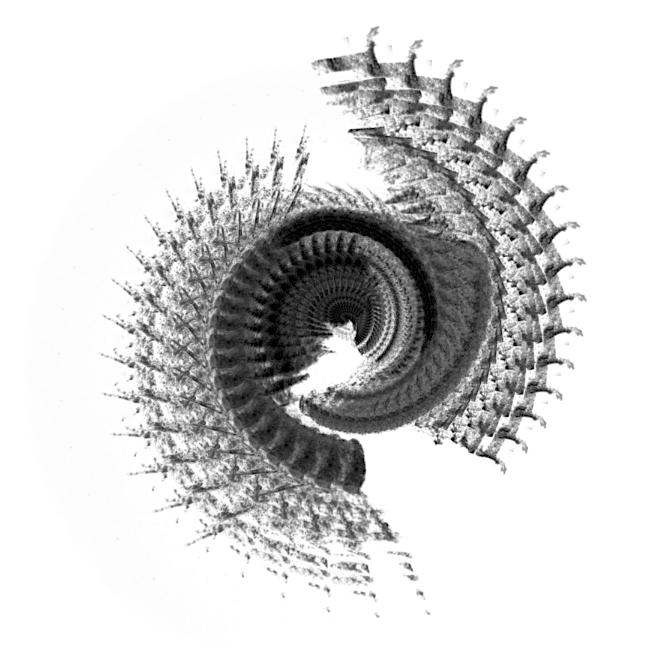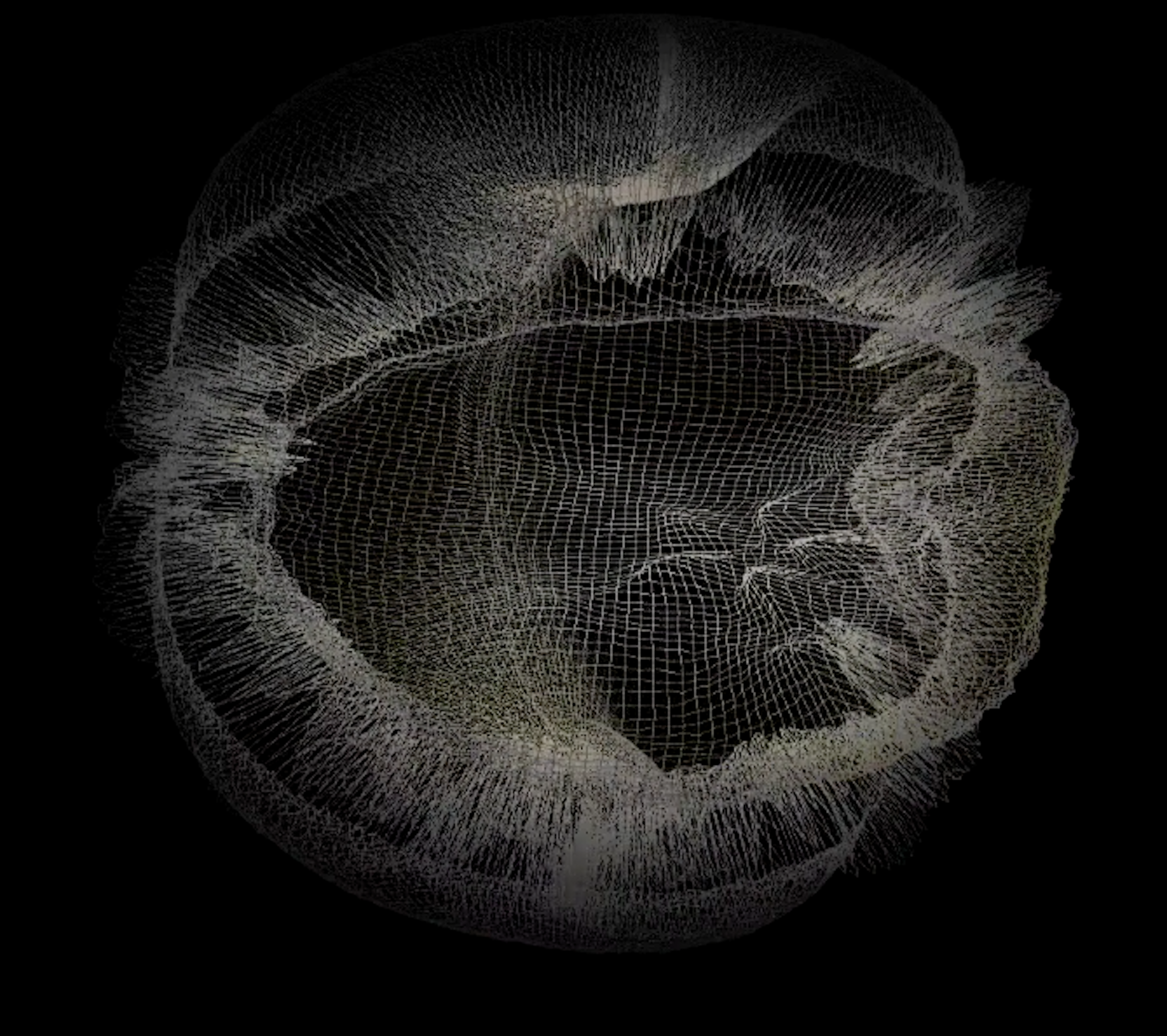This exposition is published in the Proceedings of the 1st symposium Forum Artistic Research: listen for beginnings.
Big Resonators and Earpieces
Eléonore Bak
1 Airborne and solid-borne listening
Since my childhood, I have been very sensitive to a kind of listening by echolocation and conduction, particularly when it comes to identifying underground water and other undulatory phenomena, for example the formation of air bubbles due to the heating of an area, their growth, bursting and disappearance.
If I may distinguish between airborne and solid-borne listening, for me the two are always connected in the form of tactile or sonorous-tactile events. I see them as gradual qualities of presence and as a densification of something invisible, which is nonetheless open to experience. As this experience is certainly a solitary one—one that is both commonly lived, albeit differently/unconsciously, and not yet or insufficiently identified as an entry into environments—I began to share my perceptions through drawing, action and objects.
2 The invisible landscape
The series Big Resonators grew out of a reflection on an invisible landscape. I see this landscape as a reservoir of new gestures and perceptions. The pieces (Les Grands Résonateurs, Figs. 1–5) were created and presented for the first time in 2022 at the Chapelle de l’Observance, an art center in Draguignan, as part of the exhibition Esprits des lieux, curated by Milan Garcin, and bringing together the artists Eléonore Bak, Camille Grandval and Damien MacDonald.
I began this project by exploring the cloister garden of the Chapelle de l’Observance. Searching for characteristic sound phenomena, I identified a range of frequencies and wave-like dynamics, which I then transcribed into glass sculptures. Their volumes are hollow, of varying lengths, narrow, smooth and fluted. They have openings on both sides, allowing air and sound to circulate freely in situ in vivo. They act as auditory and ocular devices.
The manufacturing process and the quality of the glass are not innocent. This glass is traditionally used in petrochemicals. Because it is machine-blown1—which allows for very precise and reproducible creations—I was able to design its shapes down to the millimetre. This was clearly necessary to achieve the desired sensory resonance.
Capable of withstanding very high pressures and temperatures (up to 1200°C, while remaining cold on the outside), glass has enabled me to work with the ambient climate. The resonators retain nocturnal humidity, which they store for quite a long time. Exposed to the sun, they heat up. As the air is also constrained by bottlenecks, this generates a certain internal dynamic: currents and mini turbulences are formed. The humidity/heat duo gives the resonators a certain internal atmosphere that can be heard (sounds that are humid, heavy, floating, swirling, harmonious, clean) and felt in the form of light pressure and other tactile effects.
I play with architecture and ambient acoustics. I use the recesses, cavities and reflective walls of the cloister to amplify the sounds and enrich them, for example with reverberation, echoes, and counter-wall effects that the listeners-explorers can experience and recognize in two modalities, using both hearing and sight. In this way, they can experience the different tones and acoustic effects, and contemplate the inner workings of the sculpted volumes, comparing their shapes and forms.
Plunging in and discovering what springs from the great nameless present, what gets in convolution, what convolves with all of this, what offers perspectives and views of landscape and architectural details: these activities explain both the origin of the specific sound signatures of the place and the causes of the resonances specific to each resonator.
The sculptures and their installation devices make it possible to (re)produce very concrete types of frequency and undulation. They let architecture and nature play their roles, and they allow to access another type of landscape, more discreet, but more revealing of what makes up the essence of the place. The place becomes both a guide and the result of an interaction between body, work and environment.
In the end, the resonators allow me to assert a personal ambition: not to be inspired by nature, but to abandon myself to it, in order to discover what remains to be sought, researched and constructed.
3 How have I arrived at these shapes?
3.1 Sound drawings by echolocation 1995–2025
Sound artworks and soundscapes are inconspicuous and not easily noticed. Hearing and sculpting sounds are solitary experiences whose potential refinement remains difficult to surround by language. Since 1995, I consequently represent my impressions of in situ, in vivo sound formations.
I call these formations ‘listening patterns’, in order to indicate that I choose them as autonomous units within environments that I have previously explored in the form of soundwalks. In these walks, I identify sectors where I feel particularly right or places where I feel ‘at home‘. One thus obtains inhabiting qualities, which become more apparent when there is a momentary and situated densification of sound, a phenomenon based on local correlations between the effects of the built form and the weather. Like architecture, the materials and vegetation present create characteristic zones in terms of thermodynamics and microclimate. I look for areas where these correlations are typical and particularly rich in terms of plasticity and sensitivity. This gives me the impression of being contained in a volume that is both inhabitable and inhabited, a sort of nesting box where all the phenomena intersect, fit together and evolve. The volume is like an architecture rich in compartments and functions, which allows me to stay there, to open intermittent windows onto the rest of the landscape, and then to enter and leave as I please.
I use a specific modus operandi which I call the plunge. This constructive experimentation consists of a slight lean to the left, a sort of tilt, a drop in fact, which I complete with a wedging of my head, a nod: movements which are barely visible from the outside. They allow me to locate these volumes and adjust to them very finely. This work is done during the day between 8.30 a.m. and 12 noon,2 when the sound is the clearest.3 It results in drawings, and each drawing takes about five minutes to reproduce (Fig. 6 shows a sound-drawing of a fountain). The drawings are quasi-blind representations of the given situation. I draw pairs (frontal [f] and back [d] to the sound source in situ and in vivo) or multiples (frontal or back to the source) while turning 180° and/or 360° to represent the whole around it. Produced in A3 (29.7 × 42 cm) and in charcoal, these drawings, which follow the same logic of graphic expression,4 can be read as a high angle shot in a plunging field.
I think that by virtue of high receptivity and creativity, the body is able to assimilate (the body as an antenna) and deal with a playing aura which means the main present: conscious and unconscious, always topical because of the convolution of bodily gestures (listening poses, plastic expressions) and ambient gestures (the yet there, not automatically conscious: the acoustic, climatic, cultural and semantic effects). The moving together of bodies and body-like beings becomes momentarily denser and shapes knots. Knots are kinds of synthetic figures of transitions, of an aesthetic, sensory and intensive summary. The discreet nevertheless concrete organisation of these knots follows a typical pattern. Afterwards I often wilfully juggle with the multi-sensorily generated meaning of the drawings, such as the interaction between seeing, feeling, touching, being touched, remembering. I also like to discover the action of a body which is not representing itself but is tracing with the aim of better inscription into the common movement. And finally, I try to understand and give more value to the sensitive contribution: I distinguish both which is given to see (figure, Gestalt) and to live (fond, multi-sensory substance).
- More rarely between 5 p.m. and 4 a.m.
- The approach is very similar to that of the photographer who looks for certain types of luminosity.
- I use charcoal because it is a very flexible medium that allows me to produce a wide variety of strokes and tones. I detect very brief events which I translate into dots; variations in sound intensity: blacks correspond to loud sounds, different greys to softer sounds, whites to silence – the latter being relative, it corresponds to what escapes my perception, for example masking effects caused by obstacles. I also detect movements, air masses and climatic changes around me. These are reflected in the momentum and orientation of points, lines and surfaces. [I also use these cues to script my animations: they are the source of the inner momentum and directionality of the simulated whole; they even allow me to (fore)see the dilution, or even dissipation, of the effects]. The blending of the effects of the built form, materials and (micro-) climate generates an autonomous corporeality whose structure, depth, relief, transparency, and momentary dynamics I seek to represent. The simulation makes this sort of slice of sound cloud explorable. The virtual eye-camera, for example, allows you to dive into the craters of this sound cloud.
My aim is then to model the drawings in 3D, to simulate the transforming morphology of a ‘sound cloud’ (Fig. 7 shows an animation), and, in a second step, to re-translate the original drawings back to sound. If all these first sound visualisations operate as an access to the given sensitive and gestural phenomena, then, later, they become a kind of perceptive and constructive habit which makes me (makes us) able to
-
carry out and test the inner construction of my sound works
-
recognise their fabrications
-
become conscious of those invisible constructions and gestures
-
understand ourselves as beings among other tempered creatures, discover and find a more conscious way back to a present, with its elastic, porous and intimate proceedings and values
-
think about incorporation of sensitive dimensions and new kinds of understanding (‘atmospherisation’ of body and mind), think about measurements within the existing models
-
derive principles for more tempered perceptions and constructions (as the big resonators presented in this article)
Figure 7: Extract of an animation which shows studies of two village fountains. I represent a systematic backbone view and a top view of a listened sound motif. The difference between the two views is that the first multiple is drawn from the front of the source (sound of running water as designed within the fountain), while the second multiple is drawn about five minutes later from the back of the same sound source. Please read these multiples from left to right and top to bottom. We can identify and compare what happens when turning 180°, for example double spins inside the motif emerge.
3.2 The re-translation of my own sound works 2019
One question important to me was how to give access to, first, the sculptural dimensions of my sounds5 and, second, the procedure of sculpting (by showing gestures deposited in the sound material, their impact on this material and the way in which I could manipulate the sound object over time) as an illustration of plastic listening at work. Mapping my sounds via RIZOM UV6 allowed me, for example, to show the making of sound buds and their woven expansions (Fig. 8) or to reveal the internal tremor of a sound structure created (Fig. 9).
3.3 The re-translation of my perceptions into sculptures 2022
A subsequent question of importance was how I could allow my audience to enter in my listening, or to put it more accurately, into the perceptive, aesthetic selection made when I am in contact with an environment and it sensitive effects. The creation of ‘écoutoirs’ (earpieces), listening boards, and resonators responds to this type of question.
The ‘écoutoirs’ (Figs. 6 and 7)7 have the status of test instruments for experiencing sensitive patterns and dynamics. Experience is always introduced and suggested by protocols such as the following: “Fill the ‘écoutoir’ with a right, because relative quantity of water, until the basic sound inside the water tank resembles the sound outside the water tank.” The protocols frame the scope of the action field, the sensitive range of listening. While offering an unprecedented learning, never really accomplished in the field, for obvious reasons, they permit to live a new binaural experience, to compare inside and outside, to test porosities, inner and outer circulations, to qualify spatial, sculptural, sensitive dimensions, but also to discover kinetic or graphic aspects of our listening.
The resonators which themselves reproduce environmental signatures are some kind of intermediate connection and contact objects between me, the listeners and the environment. I studied them beforehand by using listening habits as mentioned in the context of drawings (Fig. 8). They permit, for example, to experience/learn phenomena which are simultaneously in the ground and in the air, and then to become more attentive to (micro-)movements, (micro-)climate, micro air conditioning, turbulences, morning dew, underground atmospheres. They permit to experience/learn to adjust our bodies to sensitive phenomena and to open our bodies and minds to invisible architectures, little-identified or even unaware aspects of an environment.
-
My sound practice began with my first performances at the Cologne Stollwerk in 1982. However, it took on an autonomous form in 1985 when I was awarded a research grant, which led me to join the Sound Atelier at the Villa Arson in Nice. It was there that I met Lars Fredrikson (1926–1997), a Swedish artist, who was not only a painter, draughtsman, sculptor and visual artist, but also a pioneer in experimental sound creation and professor for sound in EPIAR Nice [F]. His perception and approach to art took me in a radical new direction, and his listening became very close. I started using a frequency generator to create sound matter, to shape it and transform it continuously. I then fixed these sounds on magnetic tape to present them as a simple stereo broadcast. By turning exclusively to sound as a material, I was able to transgress the fixity and immobility of sculpture and drawing, making them elastic and porous. So much for my way of practising and thinking about sound and listening! So much for my fundamentals! Then, in 1996, I also began to take an interest in the interaction between sound and space (with a certain predilection for curved spaces; cold, bare, semi-dark places [water tanks, for example]). Pure frequencies are diffused inside an old water tank, where they enter in circular movement. The sound relief is typified by the microgrooves left by the water on the walls, giving off a strong tactile dimension. “You should also see how she draws infinity, this elongated, stretched figure of eight that seems to twist in its vibrations. And how she recovers ‘dwellings’ to house her sounds. I remember a cistern in the countryside, you see, these basins for farmers. For their vegetables. You went in and you could hardly stay there. The ear just wasn’t used to being mistreated. But as soon as you left, you retraced your steps. The crossbreeding had taken place. How obvious! Something was happening here. All you had to do was touch the dry walls. And listen with your hands” (Sophie Braganti. 2002. Sculpter le Son, Paris: Revue Verso; own translation). As these types of sound enter in tension with the architecture and the local atmosphere, they are enriched because of the tonal qualities of the materials present and the ambient climate, and this generates non-reproducible ‘unique works’ impossible to present. From 1998 onwards, I became also interested in the structural dimension of sound, in parallel with my architectural and atmospheric experiments. I began with simulations of their possible form, by using the modelling tools developed by ACROE (Association pour la Création et la Recherche sur les Outils d'Expression) at INP Polytechnics Grenoble [F], where I met Annie Luciani, a French physicist (non-linear physical models CORDIS ANIMA, GENESIS, TELLURIS) and research engineer at the ministry of culture and communication, whose scientific and artistic approach and instrumental and ambient creativity not only appealed to me but stimulated me, and whose listening remains immensely valuable. Much later (2009) I began to use spatialization (Surround, Wave-Field-Synthesis) even for underlining the phenomenal work in progress (for instance, a cognitive audit I did in collaboration with Jean-Louis Gutzwiller, Stéphane Rossignol, both engineers and Wave-Field-Synthesis researchers at Centrale Supélec, Metz, [F], 2012–2014).
- RIZOM UV is a software that simplifies the unfolding and compacting of UV maps for 3D models.
-
The ‘écoutoirs’ have been created with the help of Jean-Marc Schilt, Thomas Schilt and Sébastien Maurer, glassblowers and craftsmen at the Centre International d’Art Verrier de Meisenthal. They follow an awareness previously made of the link between weaving and glass, thread, trembling line, sound trajectory, and horizons for the ear that are unstable and always plunging downwards.
4 Reaching a state of being
Finally, I would like to draw three links to my work. First, the problematics of ‘care’; the beauty of the vulnerable, human and not human co-presences. References are Cynthia Fleury (Ce qui ne peut être volé Charte du Verstohlen 2022), Vinciane Despret (Fabriquer des mondes habitables 2021), and Donna Haraway’s idea of ‘phonocène’ (Vivre avec le trouble 2020).8
Second, the concept of Rhythmanalysis (Henri Lefebvre) present in Macula (Eléonore Bak 2022), a rosary made up of 59 sound fragments (see Fig. 10). It connects with the pragmatist and instrumentalist epistemology of John Dewey (art as research, research by art. L’art comme expérience 2010) and the concept of “ecumene” (Augustin Berque, Ecoumène 1987).
And third, there is a group of ‘atmospheric’ researchers at CRESSON LAB ESArchitecture Grenoble9 such as Grégoire Chelkoff and Philippe Liveneau whose architectural, environmental and mental prototypes interest me particularly when they study and experience non-coincidental effects and techniques. Like these researchers, I take care of places and beings, while inviting us to live under the shade. The thinking of these researchers helps me to remain attentive and vigilant about the contamination of algorithmic being. With them, I underline that co-presences need to be experienced. And with these researchers I situate myself and my work in a certain activist thinking and doing, where art acts as sensitive enquiry and investigation and where art is understood as a knowing activity and an environmental activism. I join here a concrete ‘family’, not to draw attention to what underpins that family or that thought, but to what underpins our personal, collective and shared desire. This desire links us in a fundamental way to something that we recognise and in which we recognise ourselves. This thing is not material but sensitive. It generates unexpected, unsuspected feelings, and consequently spaces that allow thinking about them without dominating anything. These spaces, which are as unpredictable as they are elastic, are places that are both free and enclosed. On the one hand full of perceptual, temporal, sensitive and representational limits, particularly aesthetic limits. On the other hand, they make room for the unknown and places that release new qualities of presence. These qualities inhabit us, founding and reinforcing our desire, initiating our modes and methods, to the point of making sense and meaning within our work, which, moreover, is just as dependent on their emergence as it is attentive to their representational incompleteness and instability.
Representational instability has been used to question the validity of paradigms in modern science, but also in the visual arts, as in the case of the transition from figuration to abstraction. Representational instability therefore fulfils a critical function, which I shall summarise as follows: its first quality is to remind us that everything is in motion, its second is to train us for movement and action, and its third is to encourage us to mobilise in favour of the free circulation of ideas. This is its real strength. Because while it conveys the different ideas we have of the world, it also expresses the fact of communicating these ideas. The transition to different representational modes is therefore also a transition to different ideas, ideas that we are constantly discovering, exploring and negotiating. Ideas that we have the freedom and fortune to share, ideas which can transform us and our expectations. Ideas we introduce and apply in our projects.
I would like to conclude with a mental exercise proposed by the philosopher Peter Frederick Strawson.10 In Individuals, he imagines a purely sonic individual, whose sounding body is audible to him alone. When two individuals meet at the same pitch, or almost the same pitch as their own, the result would be perfect communication. This metaphysical approach reminds us that we become indeed these sonorous individuals when we transgress appearances to reach a state of being.
- The Phonocene is a philosophical proposition developed by Donna Haraway. She describes here a geological era, a time when we would pay attention to the sounds of the Earth to take care of it. The idea is to listen and be present together to take care of what remains in ill places.
- https://aau.archi.fr/cresson/membres/ (accessed 14 Oct 2025).
-
Peter Frederick Strawson (1919–2006) was a British philosopher who belonged to the analytic philosophy movement. He attempted to found metaphysics anew based on an analysis of individuality and language.
Figure 10: Eléonore Bak MACULA, A Sound Rosary, ESPRITS DES LIEUX exhibition, Chapelle de l'Observance, Draguignan, France ©2022. The recordings, made inside a resonator, reveal the striking of the walls by the wind flowing through the “atmospheric instrument”. The sound is arranged like a rosary to echo the ritualised rhythm of walking and thinking in prayer (we are in a former convent).
References
- Berque, Augustin. 1987. Ecoumène, Introduction à l'étude des milieux humains. Paris: Belin.
- Braganti, Sophie. 2002. Sculpter le Son. Paris: Revue Verso.
- Despret, Vinciane. 2021. Fabriquer des mondes habitables. Éghezée: Éditions Esperluète.
- Dewey, John. 2010. L’art comme expérience. Paris: Éditions Gallimard.
- Fleury, Cynthia, and Antoine Fenoglio. 2022. Ce qui ne peut être volé Charte du Verstohlen. Paris: Tracts Gallimard.
- Haraway, Donna J. 2020. Vivre avec le trouble. Vaulx-en-Velin: Les éditions du monde à faire.
- Lefebvre, Henri. 2013. Rhythmanalysis: Space, Time and Everyday Life. Bloomsbury Publishing.
- Strawson, Peter Frederick. 1959. Individuals: An Essay in Descriptive Metaphysics. London: Methuen (Translated to French: Les Individus, Essai de métaphysique descriptive, Seuil, Paris 1973).







